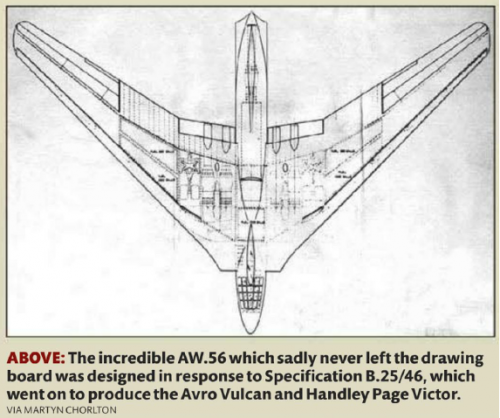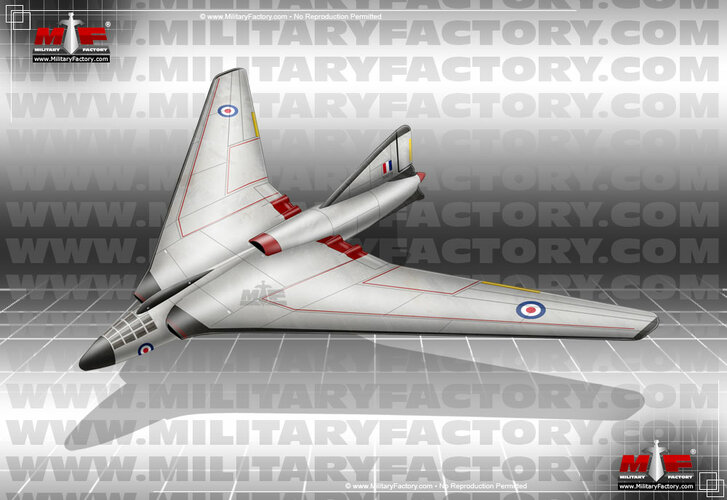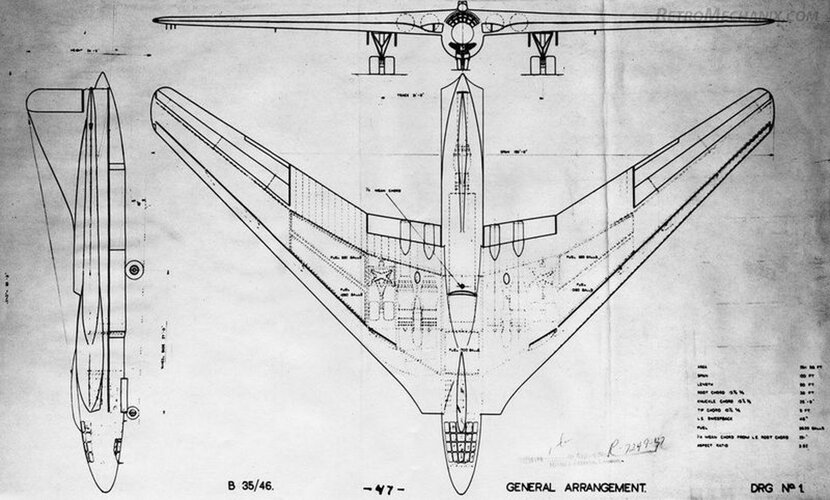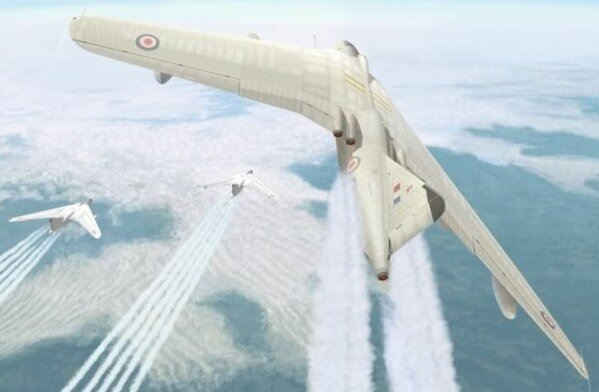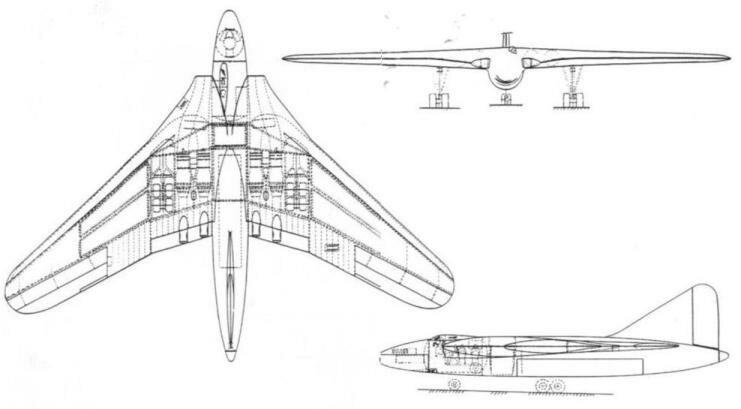You are using an out of date browser. It may not display this or other websites correctly.
You should upgrade or use an alternative browser.
You should upgrade or use an alternative browser.
Armstrong Whitworth AW.56
- Thread starter Triton
- Start date
- Joined
- 3 June 2006
- Messages
- 2,964
- Reaction score
- 3,235
2 pictures:
http://i39.servimg.com/u/f39/11/29/05/29/enigmc31.jpg
http://i39.servimg.com/u/f39/11/29/05/29/kuizz_24.jpg
Source: http://forum.avionslegendaires.net/viewtopic.php?f=5&t=6181
The 3-view is probably from the book "British secret projects" by Tony Butler.
Dear Mods, at this computer right now I'm not allowed to download or attach these pictures.
That's why I'm only posting the links. If these pictures do not violate copyright or forum rules, feel free to attach them.
http://i39.servimg.com/u/f39/11/29/05/29/enigmc31.jpg
http://i39.servimg.com/u/f39/11/29/05/29/kuizz_24.jpg
Source: http://forum.avionslegendaires.net/viewtopic.php?f=5&t=6181
The 3-view is probably from the book "British secret projects" by Tony Butler.
Dear Mods, at this computer right now I'm not allowed to download or attach these pictures.
That's why I'm only posting the links. If these pictures do not violate copyright or forum rules, feel free to attach them.
Armstrong Whitworth AW.56 Tailless Jet V Bomber Proposal of 1947
Check out this article on the Armstrong Whitworth AW.56 tailless jet V bomber proposal of 1947 at RetroMechanix.com:

The article is based on an intelligence report provided to the U.S. Air Force Deputy Chief of Staff by the American Military Attache in London and features seven high resolution drawings of the aircraft and its various components.
-Jared
Check out this article on the Armstrong Whitworth AW.56 tailless jet V bomber proposal of 1947 at RetroMechanix.com:

The article is based on an intelligence report provided to the U.S. Air Force Deputy Chief of Staff by the American Military Attache in London and features seven high resolution drawings of the aircraft and its various components.
-Jared
This thread is confusing me. I clearly see an aircraft WITH a Tail, here, even if it is just a full vertical one, and horizontal stubs. I do not understand the "tailless' description. Not only That-but it appears that the entire tail section on the 56 was an afterthought, crudely added on to the "tailless" version..Isn't this A.W. 56 just the envisioned end result of the A.W. 52? (which was TRULY a "tailless" A.W. design?) shown below, as scanned from negatives in my files.
Here are photos of the two A.W. 52s. The first one, (and first one shown here) was the 1947 design with Nene engines. The second one had the Derwent engines. As I understand it, they were designed with an eventual tailess four or six engined model, to evolve from this.


Here are photos of the two A.W. 52s. The first one, (and first one shown here) was the 1947 design with Nene engines. The second one had the Derwent engines. As I understand it, they were designed with an eventual tailess four or six engined model, to evolve from this.


Nice photos of the AW.52! According to Wikipedia, "...a tailless aircraft traditionally has all its horizontal control surfaces on its main wing surface. It has no horizontal stabilizer - either tailplane or canard foreplane (nor does it have a second wing in tandem arrangement). A 'tailless' type usually still has a vertical stabilising fin (vertical stabilizer) and control surface (rudder)."
http://en.wikipedia.org/wiki/Tailless_aircraft
Also, I think the AW.56 is a substantially different design from the AW.52, the latter almost being a pure flying wing.
http://en.wikipedia.org/wiki/Tailless_aircraft
Also, I think the AW.56 is a substantially different design from the AW.52, the latter almost being a pure flying wing.
- Joined
- 27 December 2005
- Messages
- 16,924
- Reaction score
- 21,798
Yes, "Tailless" refers to the lack of horizontal tailplanes or canards.
blackkite
Don't laugh, don't cry, don't even curse, but.....
- Joined
- 31 May 2007
- Messages
- 8,597
- Reaction score
- 6,844
Hi!
http://duhraviationart.com/index.php/portfolio/armstrong-whitworth-aw-56/
https://www.militaryfactory.com/aircraft/contractor.asp?thisCompany=Armstrong Whitworth
"The four fuselage-based engines were to be 4 x Rolls-Royce "Avon" AJ.65 turbojet types of 6,500lb thrust (each) slipped into the wing-body section while a fifth turbojet of same make, model, and output power was to be installed in the aft-section of the fuselage to provide additional thrust. As this remained an air-breathing engine, the unit was to have been aspirated through a small, semi-circular intake positioned along the dorsal line of the fuselage near midships."
http://duhraviationart.com/index.php/portfolio/armstrong-whitworth-aw-56/
https://www.militaryfactory.com/aircraft/contractor.asp?thisCompany=Armstrong Whitworth
"The four fuselage-based engines were to be 4 x Rolls-Royce "Avon" AJ.65 turbojet types of 6,500lb thrust (each) slipped into the wing-body section while a fifth turbojet of same make, model, and output power was to be installed in the aft-section of the fuselage to provide additional thrust. As this remained an air-breathing engine, the unit was to have been aspirated through a small, semi-circular intake positioned along the dorsal line of the fuselage near midships."
Attachments
Last edited:
blackkite
Don't laugh, don't cry, don't even curse, but.....
- Joined
- 31 May 2007
- Messages
- 8,597
- Reaction score
- 6,844
Attachments
blackkite
Don't laugh, don't cry, don't even curse, but.....
- Joined
- 31 May 2007
- Messages
- 8,597
- Reaction score
- 6,844
https://raigap.livejournal.com/50361.html?thread=2233
"As a power plant, four-, five- and six-engine options were provided. The first (color) and second (black-and-white) figures show a five-engine version with the upper location of the fifth air intake and the location of the fifth engine in the tail of the aircraft. More elaborate versions of the project (third figure) had four or six engines located at the rear of the powerful wing with the location of the air intakes on its leading edge.
The aircraft was supposed to install a powerful boundary layer control system. The chassis was tricycle with a two-wheeled nose strut of variable height and four-wheeled main struts, which were retracted into special wing compartments. "
"As a power plant, four-, five- and six-engine options were provided. The first (color) and second (black-and-white) figures show a five-engine version with the upper location of the fifth air intake and the location of the fifth engine in the tail of the aircraft. More elaborate versions of the project (third figure) had four or six engines located at the rear of the powerful wing with the location of the air intakes on its leading edge.
The aircraft was supposed to install a powerful boundary layer control system. The chassis was tricycle with a two-wheeled nose strut of variable height and four-wheeled main struts, which were retracted into special wing compartments. "
Attachments
Last edited:
Similar threads
-
Armstrong Whitworth AW.171 Super Sonic VTOL Flying Wing Project
- Started by GTX
- Replies: 17
-
Armstrong Whitworth AW.66 and AW.65 projects
- Started by hesham
- Replies: 10
-
-
-


